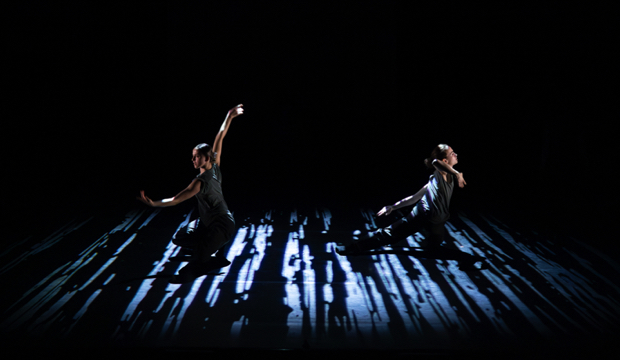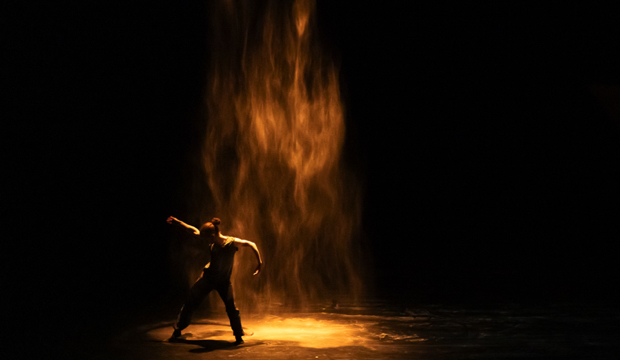Russell Maliphant Dance Company, Vortex, BBC Four
The latest work from choreographer Russell Maliphant, Vortex, which alludes to his fascination with the American abstract painter Jackson Pollock, comes to BBC Four
RMDC Vortex. Photo: Roswitha Chester
BBC Four is broadcasting the latest work from the choreographer Russell Maliphant, Vortex, which premiered at Sadler's Wells last Spring.
It's in many ways a fascinating piece, inspired by Jackson Pollock's paintings, which should sit perfectly well on the small screen.
Below is Culture Whisper ★★★★★ review of its stage performance
There is always something painterly in the dances created by Russell Maliphant, to a large extent the combination of sculptural lighting and the slow yearning movement of sinuous bodies to produce flowing images that merge into each other to hypnotic effect.
It’s not surprising, then, that the choreographer should have explicitly drawn inspiration from Abstract Expressionism, and in particular Jackson Pollock, whose paintings are more often than not the result of paint flung at the canvas, movement and colour resolving themselves into shape and image.
Maliphant was fascinated not only by the paintings themselves but, having watched documentary films of the painter at work, by the very movement of his body in the creation process.
Vortex is the product of that fascination. It’s not a realistic depiction of Pollock at work – it could never be, that’s not what Maliphant does. However, the allusions to the painter, his relationship with his canvases and the paintings themselves are there.
The piece starts with one man standing before an oversized canvas mounted on an easel. The scene is lit from above by a murky orange light. Gradually piano music establishes itself.
The man, dancer Charlie Brittain looking a little like a young Maliphant, considers and caresses the canvas as if interrogating its possibilities. His arms spread softly to encompass the full width of the canvas, his legs bend in the deep pliés of tai chi, which has long been a central element of Maliphant’s style, a fusion of many movement disciplines, which here also borrows gently from breaking and popping.
Two women, popping specialist Paris Crossley, and Meghan Stevens, emerge from behind the canvas and join him in feeling that vast surface. Grids of ragged black and white lines are projected onto the ground and the women appear to plunge into them.

RMDC Vortex. Photo: Roswitha Chester
Then the canvas, too, is criss-crossed by lines of colour. The final two members of the five-strong cast, Gabriel Ciulli and Alex Thirkle, join in.
Unceasing movement, always earth-bound, runs through the piece, its energy flowing unbroken through the five performers, all perfectly in tune with the Maliphant style. The easel, too, is moved around a lot, as if performing a dance of its own, the effect marred by its obvious weight and the noisy, cumbersome operation of its wheels and brakes.
After the interval Maliphant introduces a new element: an extended shower of white sand slowly creates patterns on the stage, which shift incessantly as the dancers' feet disturb the fallen sand. The hoped-for effect, to create something resembling a Pollock painting, is not immediately apparent, though.

RMDC Vortex. Photo: Roswitha Chester
Vortex is danced to an unobtrusive piano score specially commissioned from the American composer Katya Richardson. Lighting design, playing on Maliphant’s preferred patterns of soft light and shadow, is by Ryan Joseph Stafford; the loose, dark-hued practice costumes come from regular Maliphant collaborator Stevie Stewart, formerly of BodyMap.
Vortex has moments of intense beauty, but does not rank alongside Russell Maliphant’s best, most hypnotic works. Its effect is often muted, its narrative arc not strong enough to cast and hold the choreographer’s customary spell.
It's in many ways a fascinating piece, inspired by Jackson Pollock's paintings, which should sit perfectly well on the small screen.
Below is Culture Whisper ★★★★★ review of its stage performance
There is always something painterly in the dances created by Russell Maliphant, to a large extent the combination of sculptural lighting and the slow yearning movement of sinuous bodies to produce flowing images that merge into each other to hypnotic effect.
It’s not surprising, then, that the choreographer should have explicitly drawn inspiration from Abstract Expressionism, and in particular Jackson Pollock, whose paintings are more often than not the result of paint flung at the canvas, movement and colour resolving themselves into shape and image.
Maliphant was fascinated not only by the paintings themselves but, having watched documentary films of the painter at work, by the very movement of his body in the creation process.
Vortex is the product of that fascination. It’s not a realistic depiction of Pollock at work – it could never be, that’s not what Maliphant does. However, the allusions to the painter, his relationship with his canvases and the paintings themselves are there.
The piece starts with one man standing before an oversized canvas mounted on an easel. The scene is lit from above by a murky orange light. Gradually piano music establishes itself.
The man, dancer Charlie Brittain looking a little like a young Maliphant, considers and caresses the canvas as if interrogating its possibilities. His arms spread softly to encompass the full width of the canvas, his legs bend in the deep pliés of tai chi, which has long been a central element of Maliphant’s style, a fusion of many movement disciplines, which here also borrows gently from breaking and popping.
Two women, popping specialist Paris Crossley, and Meghan Stevens, emerge from behind the canvas and join him in feeling that vast surface. Grids of ragged black and white lines are projected onto the ground and the women appear to plunge into them.

RMDC Vortex. Photo: Roswitha Chester
Then the canvas, too, is criss-crossed by lines of colour. The final two members of the five-strong cast, Gabriel Ciulli and Alex Thirkle, join in.
Unceasing movement, always earth-bound, runs through the piece, its energy flowing unbroken through the five performers, all perfectly in tune with the Maliphant style. The easel, too, is moved around a lot, as if performing a dance of its own, the effect marred by its obvious weight and the noisy, cumbersome operation of its wheels and brakes.
After the interval Maliphant introduces a new element: an extended shower of white sand slowly creates patterns on the stage, which shift incessantly as the dancers' feet disturb the fallen sand. The hoped-for effect, to create something resembling a Pollock painting, is not immediately apparent, though.

RMDC Vortex. Photo: Roswitha Chester
Vortex is danced to an unobtrusive piano score specially commissioned from the American composer Katya Richardson. Lighting design, playing on Maliphant’s preferred patterns of soft light and shadow, is by Ryan Joseph Stafford; the loose, dark-hued practice costumes come from regular Maliphant collaborator Stevie Stewart, formerly of BodyMap.
Vortex has moments of intense beauty, but does not rank alongside Russell Maliphant’s best, most hypnotic works. Its effect is often muted, its narrative arc not strong enough to cast and hold the choreographer’s customary spell.
TRY CULTURE WHISPER
Receive free tickets & insider tips to unlock the best of London — direct to your inbox
| What | Russell Maliphant Dance Company, Vortex, BBC Four |
| Where | BBC Four | MAP |
| When |
On 21 Jan 24, 21:00 Dur.: 1 hour 30 mins approx |
| Price | £FREE |
| Website | https://www.bbc.co.uk/bbcfour |